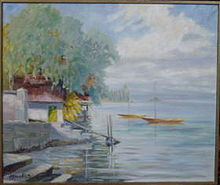Heinrich Hauber
Heinrich Hauber (* 1904 in Langenargen on Lake Constance , † 1983 in Horn ) was a German painter.
Life
Heinrich Hauber was born in 1904 as the ninth of 13 children. His father was a master cheese maker with his own cheese factory in the Allgäu . Heinrich showed musical interests at an early age. He loved music and would have liked to have done it professionally, but painting fascinated him most of all. In every free minute he drew or thought about painting. During this time, Hauber decided to train as an artist. So that the civil and practical occupation that his father had given him to learn still contained an idea of his ideas, he convinced his father to train as a flat painter and decorative painter . After this training he went to Berlin and attended the Reimann Art School, which was very well known at the time, for two years.
In the early 1920s, Heinrich Hauber and his parents moved to Hemmenhofen on Lake Constance . The painter Haberkorn from Frankfurt had set up his domicile there and noticed the young man. He taught him art painting for a year. Heinrich Hauber later found a little fulfillment in his love for music as an active member of Höri music, together with Ludwig Finckh , the founder of the artist colony of Höri painters .
After further training in Berlin, Hauber settled in Horn on the Untersee in 1928 , founded a family and worked as a freelance painter. The portrait opposite, painted in 1934 by Walter Waentig , was created during this time. He mainly sold his landscape motifs and still lifes with flowers to Switzerland. From 1940 to 1945 Heinrich Hauber had to take part in the Second World War as a soldier despite his six children . He did this with great inner reluctance and only survived because he was very lucky due to a wound in a hospital stay. A doctor extended his stay for a few months longer than necessary, had him paint pictures for himself and thus saved him from a second front-line assignment in Russia.
After the war Heinrich Hauber was again a freelance painter. Although he was repeatedly forced to secure his income with other activities, despite the relatively good sales success of his pictures, he painted very diligently, especially the Lake Constance, which he loved so much. He captured Lake Constance and its landscape in all moods and in all seasons in oil and watercolor paintings . He struggled with himself and his style to always improve the way of expression in order not only to paint representatively, but to give his pictures as much life, soul and sensations as possible, which nature itself conveyed to him. He also preferred the nearby mountains in Austria and Switzerland as motifs. Heinrich Hauber went on short study trips to France, Italy and Holland.
Painting was a need for Heinrich Hauber, but it was not always possible to make a living from art alone. Again and again he was forced to mobilize others of his talents to earn additional money to enable his family to materially exist. He often took part in exhibitions in southern Germany. A solo exhibition never took place for reasons of cost.
Since life was a struggle for him and, as a realistic person, he saw the evil and the bad in the world with open eyes, it was a great need for him, not the struggle, the ugly, the abnormal or even death and destruction on his own To depict pictures (as experienced as a soldier in World War II), but rather to depict the uplifting, peaceful, nature in its strength and beauty as a balance. After the war, Heinrich Hauber was confronted with the development of abstract painting in art, with the fact that his representational, realistic-looking painting was officially no longer in demand. Rather , what was promoted and bought was modern, abstract painting , with a wide variety of isms, which, in his opinion, more and more had nothing to do with art and especially painting. This circumstance depressed him, made him increasingly resigned, even paralyzed his work for a time and over the years caused him to withdraw completely and no longer to be present at exhibitions. He did not seek the development of abstract painting artistically, but lived through it in long discussions with his then friend Max Ackermann . Heinrich Hauber u. a. through the friendship with the photographer Hugo Erfurth .
Nevertheless, he worked on his individual style in the studio in Haus Elisabeth (Horn) and in the great outdoors, as long as his health allowed it. He always did this with the great need to depict the beauty of nature.
Heinrich Hauber died in Horn in autumn 1983.
Works by Heinrich Hauber are now in the Hermann Hesse Höri Museum.
| personal data | |
|---|---|
| SURNAME | Hauber, Heinrich |
| BRIEF DESCRIPTION | German painter |
| DATE OF BIRTH | 1904 |
| PLACE OF BIRTH | Langenargen on Lake Constance |
| DATE OF DEATH | 1983 |
| Place of death | horn |


